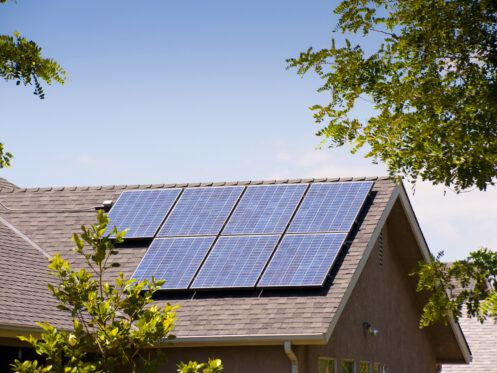The photovoltaic effect, a scientific principle, enables solar panels to convert sunlight into energy. Sunlight interacts with semi-conductive materials inside the solar panel, resulting in the generation of electricity. Homeowners considering solar panel installation can benefit from understanding how these panels capture and transfer solar energy into usable electricity for their homes, and potentially for selling back to the electrical utility company.
Photoelectric and Photovoltaic Effects
The photoelectric and photovoltaic effects are closely intertwined phenomena crucial to solar energy generation.
The photoelectric effect occurs when materials are exposed to specific light spectrums, enabling them to absorb photons from sunlight. These absorbed photons energize electrons within the material, causing them to break free from their atomic bonds. This liberation of electrons results in the creation of current and voltage.
The photovoltaic effect elevates this process further. During this process, photons from sunlight are absorbed into the solar cell. This absorption energizes electrons within the cell material, allowing them to escape their atomic bonds and become free.
Solar cells are equipped with a PN junction comprised of semiconductor materials. This junction organizes the flow of free electrons, facilitating the creation of electricity. So, while both effects harness solar energy by liberating electrons through photon absorption, the photovoltaic effect operates within a structured semiconductor environment to efficiently generate electricity.
Understanding Semiconductors and Their Role in Solar Panels
Semiconductors play a pivotal role in enabling the photovoltaic effect within solar panels, which facilitates the conversion of solar energy into electricity. Here’s a closer look at how semiconductors function in this process.
Semiconductors, unlike insulators, can conduct electricity to some extent but not as effectively as conductors. Silicon stands out as a popular semiconductor material in solar panels due to its abundance and favorable electrical properties for solar energy conversion.
Solar panels typically contain silicon wafers, which are extremely thin slices of crystalline silicon. These wafers undergo a process called doping, where impurities are introduced to the silicon crystal, creating a natural electrical field within the material.
Doping involves adding atoms with extra electrons (n-type doping) or atoms with missing electrons (p-type doping) to the silicon crystal. This process results in the formation of a PN junction, a boundary layer within the silicon material crucial for the photovoltaic effect to occur.
When photons from sunlight strike the surface of a solar panel, they excite electrons within the semiconductor material, causing them to move freely through the crystal. The electric field established by the PN junction directs the movement of these electrons, facilitating the generation of electric current.
In summary, semiconductors, particularly silicon, serve as the foundation for solar panels. They allow them to harness sunlight and convert it into usable electricity through the photovoltaic effect.
Essential Components of a Solar Panel System
A solar panel system comprises several key components that work together to generate and utilize electricity from sunlight. Here are the main components.
Solar Panels
Solar panels are the primary components responsible for capturing sunlight and converting it into electricity. They consist of photovoltaic cells arranged in series and parallel configurations to form a solar array.
Charge Controller
The charge controller regulates the voltage and current from the solar panels to ensure efficient charging of connected batteries. It prevents overcharging or undercharging of batteries, thereby safeguarding their lifespan and performance.
Battery
Batteries store the electricity generated by the solar panels for use during periods of low sunlight or at night. They serve as energy reservoirs, providing power when sunlight is unavailable.
Inverter
The inverter is essential for converting the direct current (DC) electricity produced by the solar panels and stored in batteries into alternating current (AC) electricity. AC electricity is compatible with standard household appliances and the electrical grid, allowing solar energy to power various devices and applications in homes or businesses.
Together, these components form a complete solar panel system, enabling the harnessing of solar energy for electricity generation and utilization.
Turning Sunlight Into Electricity
After absorbing photons from the sun, solar panels initiate the process of electricity generation by exciting electrons within semiconductor materials. These excited electrons create an electric current as they move through the material.
Following electron excitation, the next phase involves the collection of the generated electric energy. Solar panels feature metal grid lines designed to capture this energy. These grid lines act as conductors, guiding the electricity toward the inverter.
Since the energy produced by the solar panel is in the form of direct current (DC), the inverter plays a crucial role in converting it into alternating current (AC), compatible with most electrical devices. The converted electrical current can then be integrated into the home or business electrical grid or stored in batteries for future use. This conversion process ensures the versatility and compatibility of solar energy for various applications and needs.
Examining the Pros and Cons of Solar Power Utilization
Advantage: Renewability
Solar energy is renewable, minimizing carbon emissions and avoiding environmental damage associated with fossil fuel extraction. It requires minimal water usage compared to traditional power plants.
Advantage: Reduced Electric Bill
Solar energy reduces reliance on the electrical grid, potentially leading to savings on electric bills. Excess energy generated can be sold back to utility companies. Even small-scale solar solutions like solar lights offer savings and backup lighting during grid outages.
Advantage: Tax Credit
States offer solar renewable energy certificates, allowing homeowners to sell them to utility companies and providing an additional revenue stream.
Advantage: Increased Home Value
Homes with solar panels can command higher prices and may be worth up to $15,000 more than similar homes. Solar panel installation and maintenance are relatively hassle-free.
Advantage: Consistent Energy Production
Solar systems operate regardless of temperature, with snowfall even improving efficiency by cleaning panels. While cloudy weather can impact output, solar energy remains a constant energy source.
Disadvantage: Initial Cost
The upfront cost of solar panel installation can be significant, although declining prices and tax incentives mitigate this expense.
Disadvantage: Energy Storage Costs
Solar panels rely on sunlight, necessitating energy storage solutions like lithium-ion batteries, which can be costly to purchase and replace.
Disadvantage: Roof Compatibility
Solar panels require direct sunlight and may not be suitable for all roof types. Some materials, like metal and asphalt, are conducive to solar installation, while others, like slate or clay, may require more expensive insulation.
Understanding the advantages and disadvantages of solar power is crucial for homeowners considering transitioning to solar energy. While the initial investment and storage costs may be barriers, the long-term benefits, including reduced energy bills and increased home value, often outweigh the drawbacks.
The Best in HVAC, Plumbing, and Electrical Services in Lincoln and Omaha, Nebraska
At John Henry's Plumbing, Heating, Air, and Electrical, we have been the leading name in electrical, plumbing, and HVAC services in our area since 1996. We are committed to providing homeowners with quality services and the best value for their money. We are a family-owned business that offers upfront pricing. We are proud winners of the Better Business Bureau integrity award and other awards and certificates highlighting our commitment to our customers.
Our services include HVAC installation, maintenance, and repair. We offer general plumbing and installation of water softeners, heaters, and filtration devices. Our electrical services include electrical panels, surge protection, electrical inspections, and indoor and outdoor lighting. Contact John Henry's Plumbing, Heating, Air, and Electrical today and let us work with you to quickly yet accurately address your plumbing, HVAC, or electrical needs.

